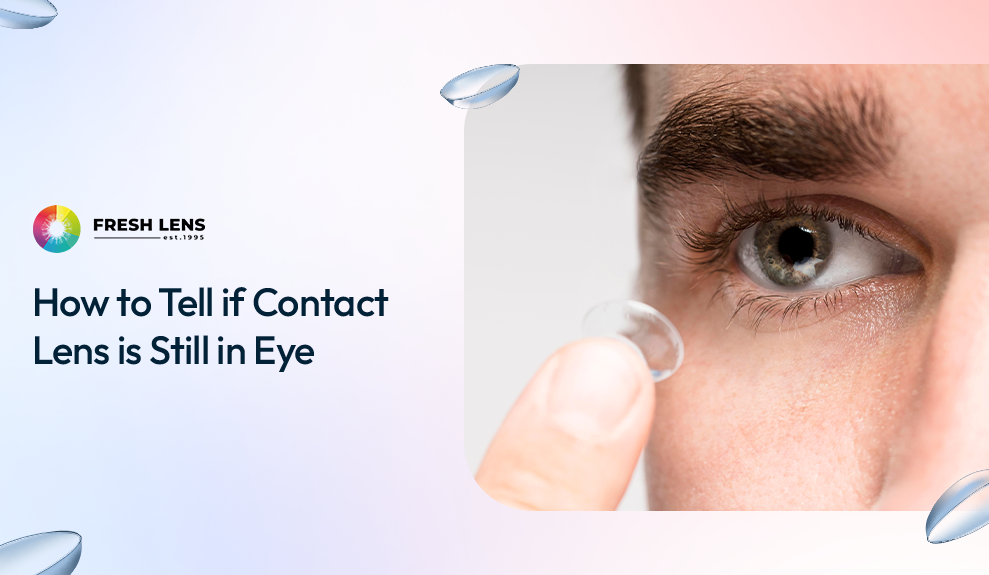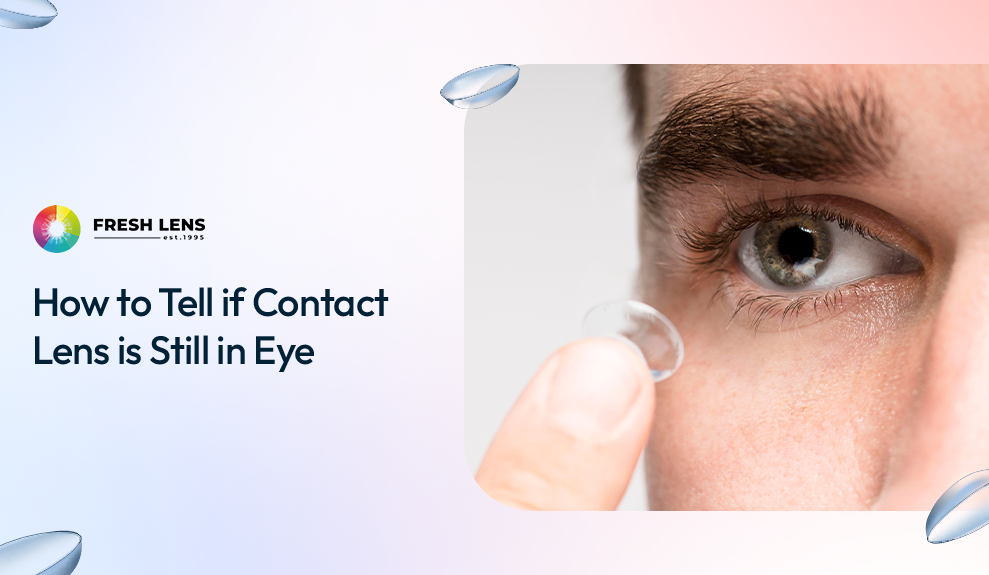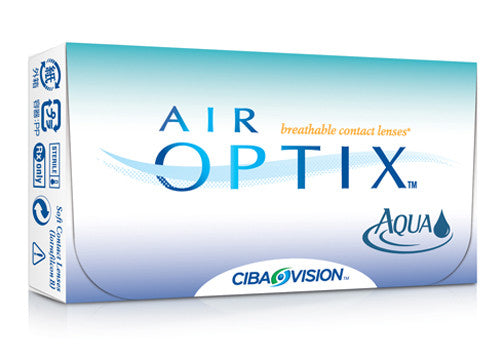
It’s a common moment of panic: you go to remove your lenses and can’t find one on your finger. Did it fall out, or is it stuck in your eye? If you’re checking if a contact lens is still in your eye, the first step is to stay calm. Contact lenses can sometimes get stuck or hide under your eyelid, but there are ways to tell if it’s still in there and safely get it out.
How Do Contact Lenses Get Stuck?
Contact lenses are meant to float on the surface of your eye, but occasionally they move out of place or stick to the eye. Here are a few common reasons a lens might get stuck:
Lens drying out: If you wear lenses too long or fall asleep in them, they can dry out and adhere more tightly to your eye. Learn more about this in The Hidden Dangers of Wearing Contacts Too Long.
Rubbing your eyes: Vigorous rubbing can dislodge a lens from the cornea and fold it under the eyelid.
Improper removal: Sometimes you might accidentally miss a lens when removing your contacts – one could stay in without you realizing.
Torn lens: If a soft lens rips, a fragment could cling to the eye while the rest comes out, making it feel like the lens disappeared.

Symptoms of a Lens Stuck in the Eye
How can you tell if a contact is still in your eye? Your eyes will usually give you some clear signals. Watch out for:
Irritation or discomfort: A sharp, scratchy feeling or the sensation that something is in your eye.
Redness: Your eye may become red or inflamed if a lens is stuck.
Dryness or grittiness: An out-of-place lens can cause unusual dryness or a sandy feeling.
Blurry vision: If the lens is stuck or folded in your eye, your vision in that eye might be blurry or foggy.
Tearing: Your eyes may water excessively as they attempt to flush out the irritation.
Keep in mind that these symptoms strongly suggest something is in your eye, but they don’t guarantee it’s the contact lens; the lens could have fallen out, and the irritation might be from a minor scratch. That’s why the next step is to check carefully.
What to Do If You Can’t Find the Lens
If you suspect a contact is lost in your eye but you can’t spot it, try the following:
Look under your eyelids: With clean hands and a mirror, gently pull down your lower lid and lift your upper lid to see if the lens is hiding there.
Add drops and blink: Put a few rewetting drops in your eye and blink several times. This may move the lens into view or even rinse it out.
Search your surroundings: If you still don’t see the lens in your eye, it might have already fallen out. Check your face, clothing, or the area around you for a dropped lens.
If you’re unsure, our blog on Can a Contact Lens Fall Out? helps explain how and when it might happen, and what to do next.
How to Safely Remove a Stuck Lens
So you’ve determined the contact lens is definitely still in your eye. Now, how do you get it out safely?
Removing Soft Contact Lenses
To remove a stuck soft lens:
- Lubricate: Put saline solution or rewetting drops in your eye to rehydrate the lens and make it easier to move.
- Locate: Look in a mirror to find the lens. Check the white of your eye and under your lids (look in the opposite direction of where you suspect the lens).
- Remove: Once you spot the lens, use your fingertip to gently slide it toward the white of your eye. Then use your thumb and forefinger to softly pinch and remove the lens. (If it’s hiding under your upper eyelid, close your eye and gently massage the lid to help move the lens down.)
If you’re unsure of your technique, review How to Remove Contact Lenses or, if you have long nails, read How to Remove Contact Lenses with Long Nails.
Removing Rigid (Gas-Permeable) Lenses
Removing a hard (RGP) lens that’s stuck is a bit different, because these lenses are small and inflexible:

- Blink method: Sometimes blinking hard will pop out a stuck RGP lens. You can also try pulling the outer corner of your eye while blinking to break the suction and release the lens.
- Use a suction cup: If blinking doesn’t work, use a small suction cup plunger designed for contact lenses. Moisten the cup and gently touch it to the center of the lens; when it adheres, pull the lens out.
Tips to Prevent a Contact Lens from Getting Stuck
While it’s not always avoidable, you can greatly reduce the chance of a stuck lens with a few smart habits:
- Follow the replacement schedule: Don’t wear lenses longer than recommended. Old lenses can warp or collect deposits that stick to your eye.
- Avoid sleeping in contacts: Unless your doctor has said your lenses are OK for overnight wear, always take them out before sleeping. Sleeping in lenses dries out your eyes and can make the lenses stick.
- Use backup glasses: If your eyes feel irritated or overly dry, give them a break by switching to eyeglasses. It’s better to rest your eyes than to keep wearing contacts when your eyes are complaining.
- Use the right lenses & checkups: Ensure you’re using the correct type of contacts for your eyes (for example, Contacts for Astigmatism if you have astigmatism) and have regular eye exams to verify your lenses fit well. A well-fitted, appropriate lens is less likely to get stuck.
- Practice good hygiene: Clean your lenses and replace the storage case regularly. The blog "Contact Lens Hygiene 101: Keeping Your Eyes Healthy and Safe" provides additional insights on this topic.
For added comfort, explore our Soft Contact Lenses collection as well as other lens options to find the best fit for your needs.
When to Contact an Eye Doctor
If you’ve tried everything and still cannot locate or remove a stuck lens, it’s time to seek professional help. An eye doctor has special tools and magnifiers to find and remove stubborn contacts safely. You should also contact your eye doctor if:
- You suspect a piece of the lens is still in your eye (for example, if a lens tore and you aren’t sure you got all of it out).
- Your eye remains irritated or your vision is blurry, even after the lens is removed. This could be a sign that your eye got scratched or needs treatment.
- Don’t hesitate to get medical help; it’s better to have an expert take a look than to risk injuring your eye by poking around.
You can also review Why Do My Contacts Burn? to learn when irritation signals a deeper issue.
FAQs
Q: Will a stuck contact lens eventually come out on its own?
A: Often it will. A dried-out contact lens might work its way to the corner of your eye or even fall out after it rehydrates with your natural tears. However, you shouldn’t wait too long in discomfort – it’s best to actively try the safe removal methods above rather than hoping it works itself out. (Remember, a lens can’t slip behind your eye, so it will come out once it’s loose.)
Q: Can you lose a contact in your eye and not feel it?
A: Usually not. If a contact lens is in your eye, you’ll almost always feel some irritation or notice the symptoms (redness, tearing, etc.). In some cases, a very thin soft lens might fold up under an eyelid where it’s not immediately felt, but within a short time, your eye will become irritated. It’s also possible to think a lens is in your eye when it actually falls out. If you don’t feel anything and your vision is normal, the lens is probably gone.
Q: What happens if I accidentally sleep with a contact stuck in my eye?
A: Sleeping in contacts not designed for overnight wear can cause the lens to dry out and stick more firmly. If this happens, apply lubricating drops as soon as you wake up, blink several times, and remove the lens gently once it’s rehydrated. If it doesn’t come out easily, give your eyes a rest and try again later.
Q: Can a stuck contact lens damage my eye?
A: Yes, if left untreated. A stuck lens can cause scratches on the cornea, irritation, or even infections if not removed promptly. That’s why it’s important to rehydrate the lens and remove it safely, and see an eye doctor if you experience pain, redness, or persistent blurry vision.
Final Tip
Remember, a contact lens can’t slip behind your eye; it’s physically impossible. With the right technique and patience, you can always remove it safely.
For ongoing comfort and eye health, you may check our guide on simple Tips and Tricks for Contact Lens Users.

































